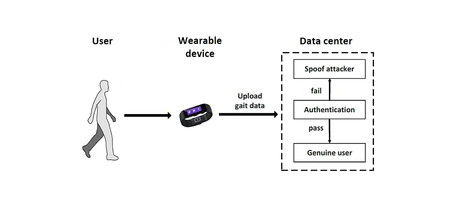Stepping up to stronger security

CSIRO Data61 researchers have developed new technology which uses the way a person walks, their gait, to power wearable devices and which could also possibly be used as a new authentication method to replace passwords, PINs or fingerprints.
Rather than looking at an individual’s unique movements, the researchers have developed a prototype wearable device that senses the wearer’s unique energy generation pattern.
Small sensors called accelerometers can currently be used to capture an individual’s gait in terms of motion and velocity.
However, this reduces the battery life of the devices and has prevented gait authentication from becoming more widely adopted.
The researchers have overcome this by combining gait recognition with kinetic energy harvesting (KEH), which translates a person’s motion into electrical energy.
“By applying both techniques we have developed a way to achieve two goals at once — powering devices and the ability to verify a person’s identity using a wearable device by capturing the energy generated from the way they walk,” said Data61’s Sara Khalifa.
The researchers conducted a trial on 20 users, having them walk on different indoor and outdoor surfaces to capture their gait.
The trial showed that KEH-Gait can achieve an authentication accuracy of 95% and reduce energy consumption by 78%, compared to conventional accelerometer-based authentication techniques.
The KEH-Gait system was also tested against ‘attackers’ who attempted to imitate an individual’s motions. The analysis found only 13 out of 100 imposter trials were wrongfully accepted by the system as genuine trials.
Group Leader of the Networks Research Group at Data61 Professor Dali Kafaar said there were benefits to the KEH-Gait approach compared to passwords, PINs, signatures and fingerprints.
“Firstly, it is convenient because as we walk around each day our gait can be sampled continuously and verified without us having to manually adjust anything,” Professor Kafaar said.
“Secondly, it’s more secure than passwords because the way we walk is difficult to mimic. Since the KEH-gait keeps authenticating the user continuously, it collects a significant amount of information about our movements, making it difficult to imitate or hack unlike guessing passwords or pin codes.”
The Data61 team is exploring other more secure and implicit continuous authentication techniques such as unique breathing patterns and distinctive behavioural biometrics from the way users innately interact with their devices.
How to harness AI to advance cybersecurity
Organisations that prioritise AI-enabled security and a culture of continuous learning...
Solving the IoT attack surface challenge: a practical playbook for IT managers
As IoT environments get more complex, adopting zero-trust architectures to verify every device...
Defending against AI-powered cyberthreats
Improving cyber resilience is no longer about perimeter defence or reactive patching, but...







